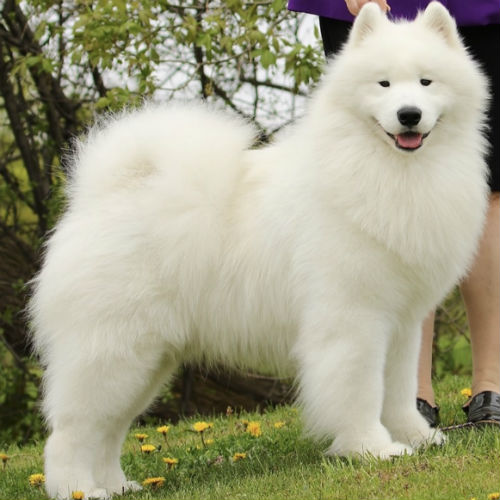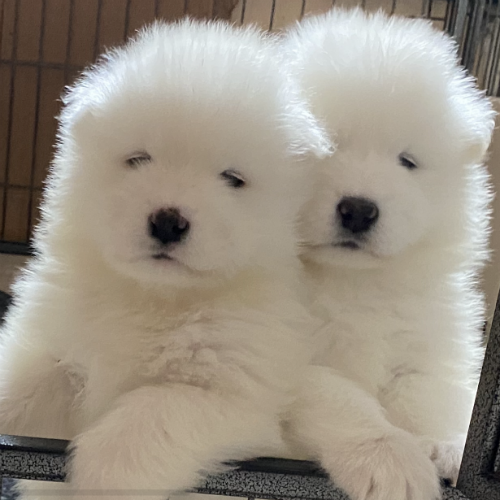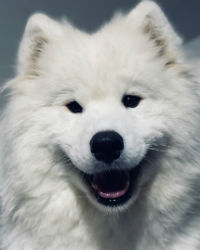Origin & Purpose – named after the Siberian nomadic Samoyede people whose livelihood depended upon migrating reindeer, the Samoyed was a herding dog who also pulled sleds, helped in the hunt, and kept the children warm in the “choom” tents that the Samoyede erected as they stopped to rest on long journeys. They were selected for several Antarctic expeditions in the late 1800’s and early 1900’s and acquired directly from Samoyede tribes for this task. Expedition survivors were then brought to England where fanciers developed a breed standard. Those original working dogs’ genes have formed what we know as the Samoyed breed today. In 1891, an early developer of the breed, described them as “lovely white Russian (Samoyed) sledge dog pups, like small polar bears, most gentle and affectionate with splendid coats and tails” Little has changed.
General Appearance – a working dog of beauty, alertness and strength, with agility, dignity, and grace: heavy and weather resistant coat. The Samoyed is a medium sized member of the Spitz family of dogs and may be the original progenitor of most of the Spitz breeds we see today. Well bred and well maintained, Samoyeds are eye arresting in their natural beauty. Their characteristic “Sammy Smile” is legendary and a hallmark of the breed.
Height/Weight – Height: Dogs 21 -23 ½ inches (53 to 60 cm) females 19-21 ½ inches (48 to 55 cm) at the withers: Weight in proportion to size: Should never be too heavy as to appear clumsy nor so light as to appear racy
Coat / Colour – double¬coated dog: body well covered with undercoat of soft, short, thick, closed wool with longer, harsher hair growing through it: outer coat stands straight out from the body: coat forms a ruff around the neck and shoulders, framing the head (more on males than females). Quality of coat should be weather resistant and consid¬ered more important than quantity: type of coat and texture is important: should glisten with a silver sheen: female coats not as long and may be slightly softer in texture. Colour: must be white, white and biscuit, white cream, cream or all biscuit. All of these colours should be considered equal. Any other colours disqualify. Curly, wavy, flat, droopy, soft or silky outercoat is extremely undesir¬able. Excessive coat length and short, smooth coats are not typical. Dense undercoat is shed seasonally: coat has no doggy odour: harsh outer coat resists dirt: many people allergic to dogs are absolutely fine with Samoyeds.
Feeding – Samoyeds do well on a multi-protein based kibble, but in particular a fish source should be included. Switching up the raw amongst the many formulas available also offers Samoyeds some variety which they enjoy. A good combination is a high quality triple protein based kibble plus a commercial frozen raw dog food.
Temperament: Sammies have outstanding temperaments due to their long association serving humans: gentle with children and the elderly: cherished as beloved family pets. Samoyeds are pack dogs and as such are happiest with their human pack and don’t prefer a solitary life. They are characters with personality plus, and usually not alpha – but they do require discipline and boundaries. Socially needy breed that must be with people: they have a strong sense of family: Thrive being among others with a “the more the merrier” attitude. Loneliness can lead to noisy and destructive behavior.
Training /Obedience – Being an intelligent and “thinking” breed, not keen on repetitive work like retrieving.
Activity and Performance: love plenty of exercise: As long as you’re with them, they’re pretty content. Samoyeds can and do protest being left behind. Loneliness can lead to noisy and destructive behavior. Doggy daycares are perfect for working families, as Samoyeds can flaunt their social nature while dog parents can rest easy knowing that their dog is not getting into trouble while home alone. Samoyeds can be used as service dogs, therapy dogs, pulling children on sleds, skijoring with adult owners.



